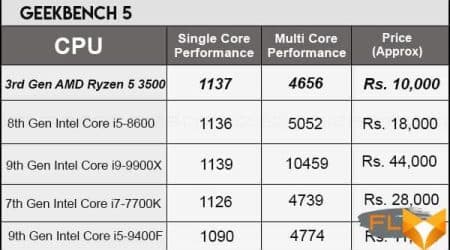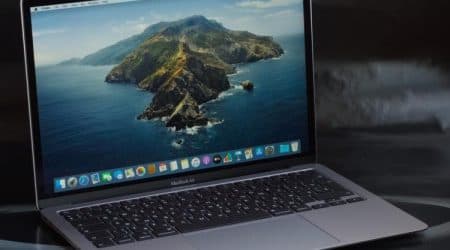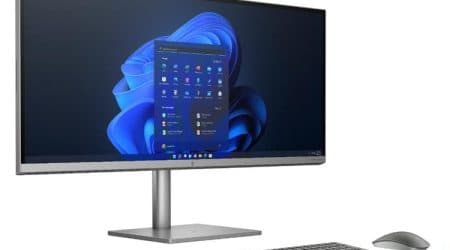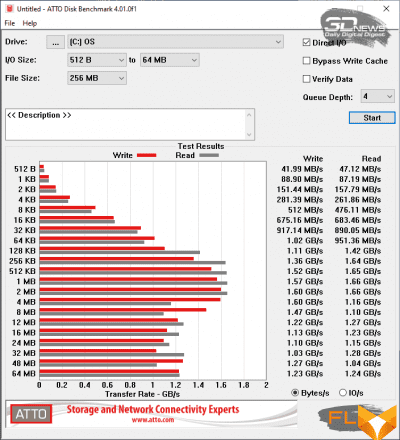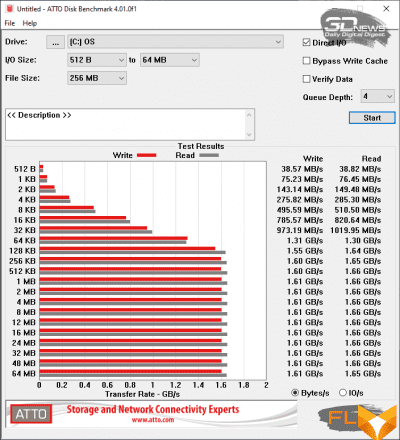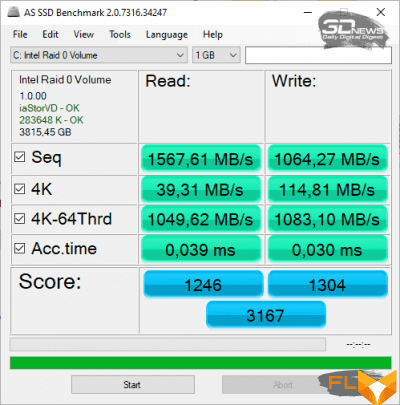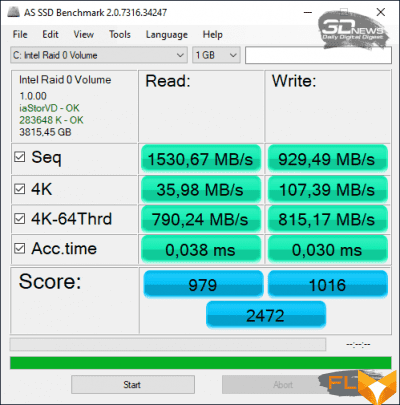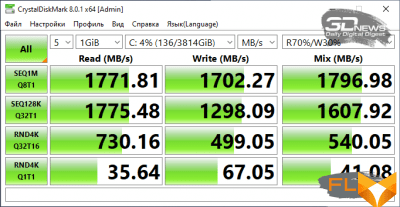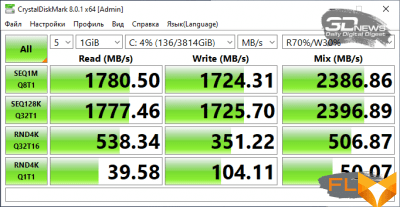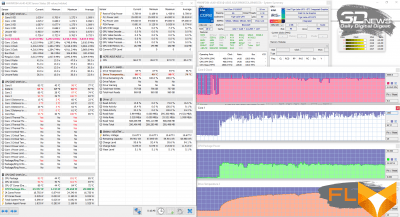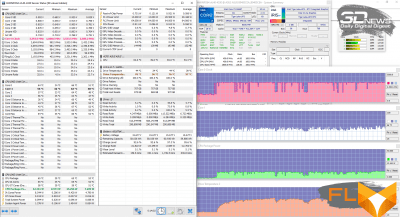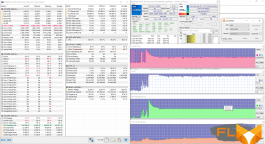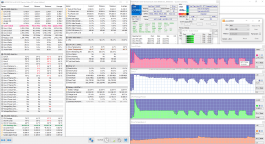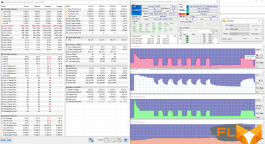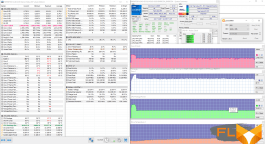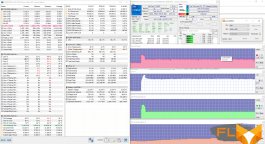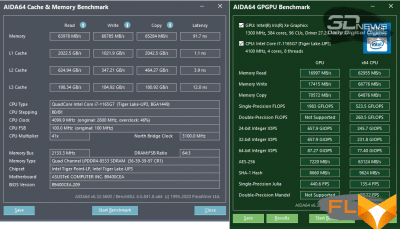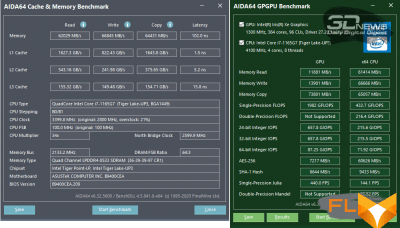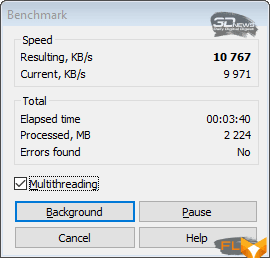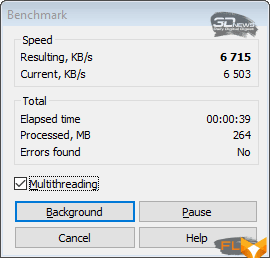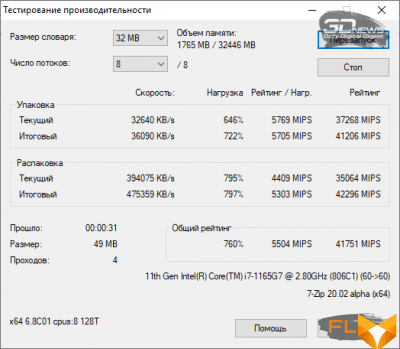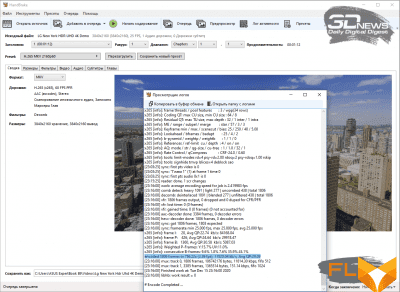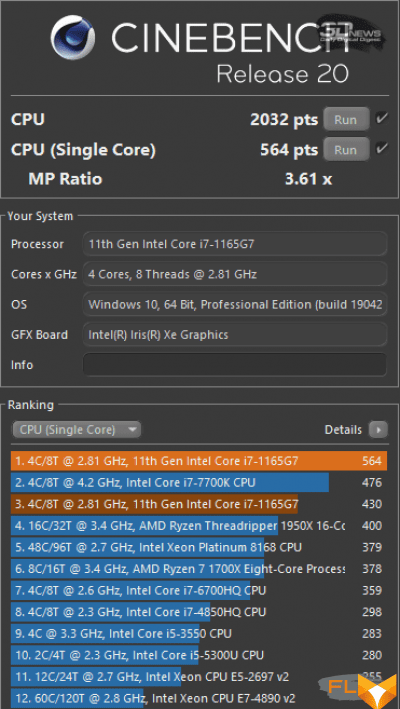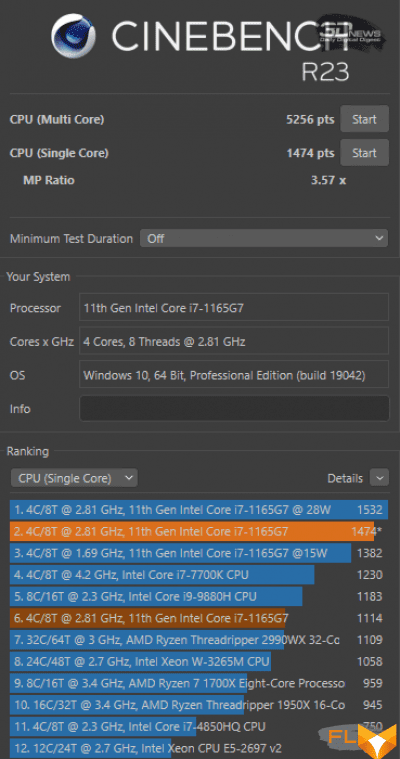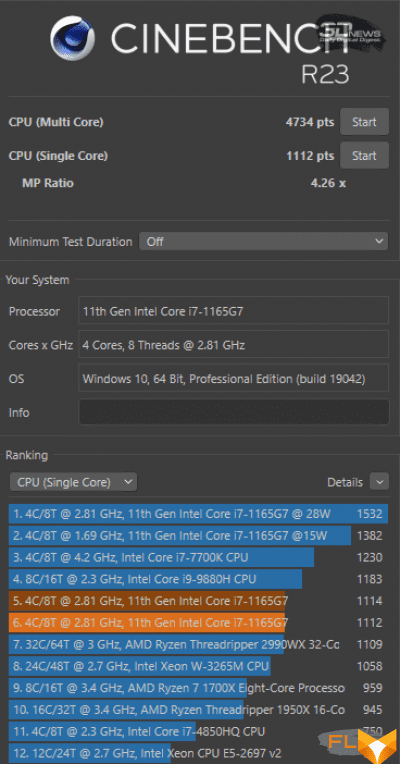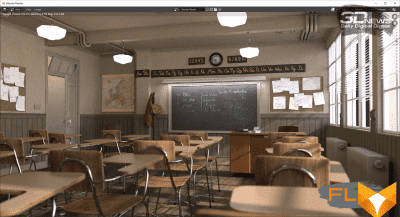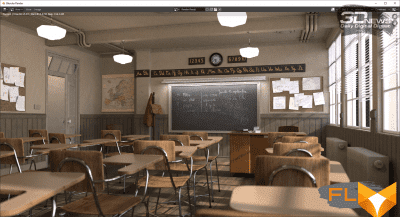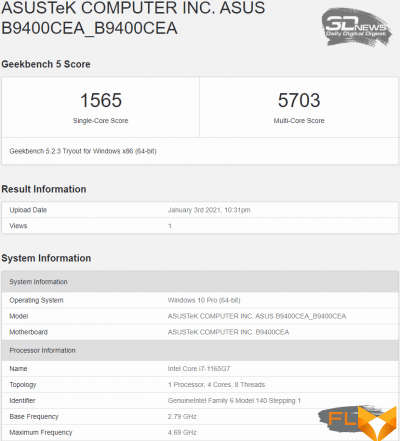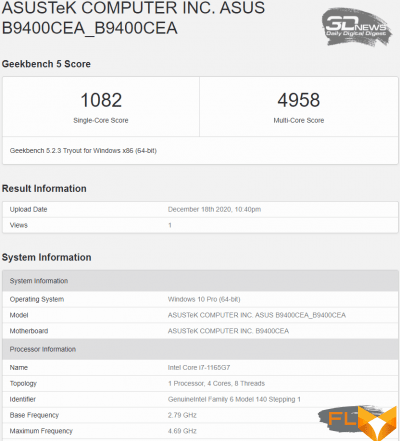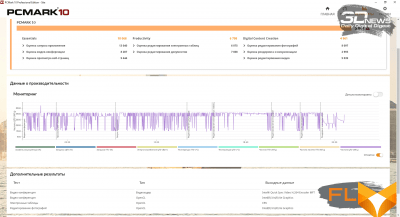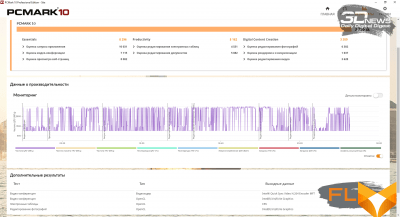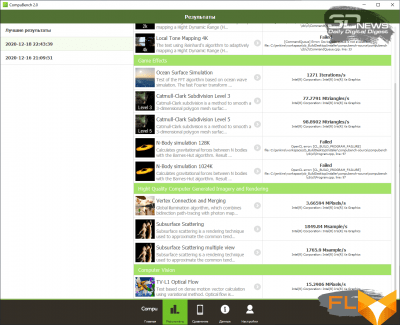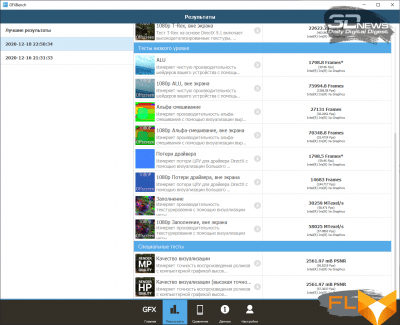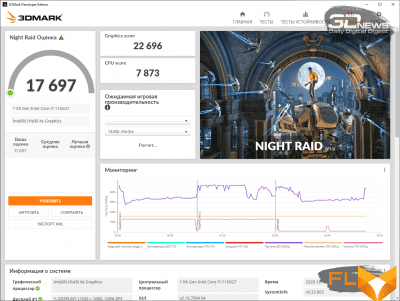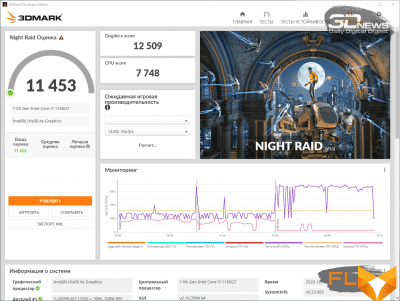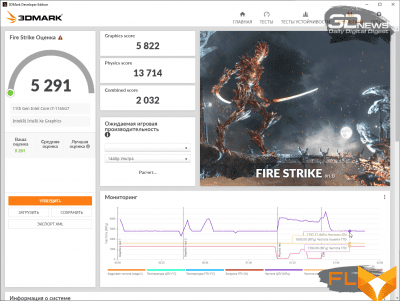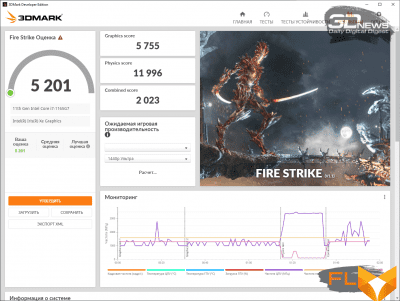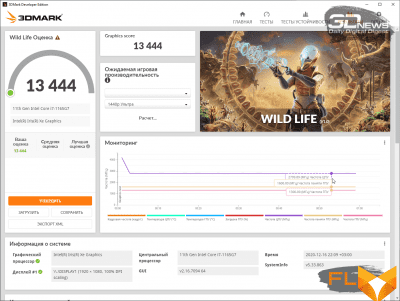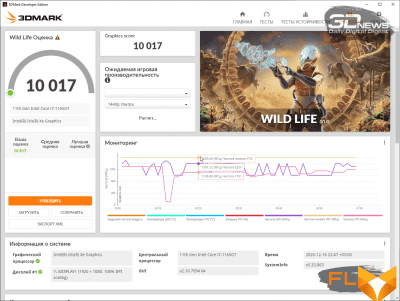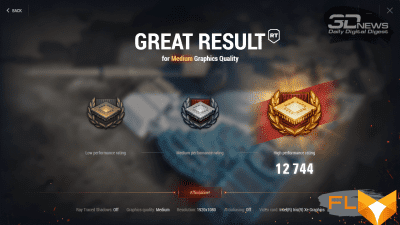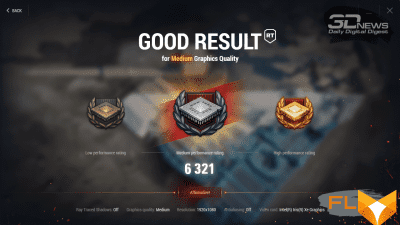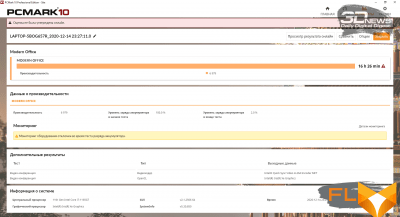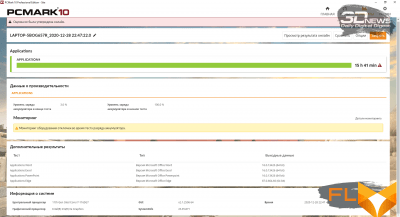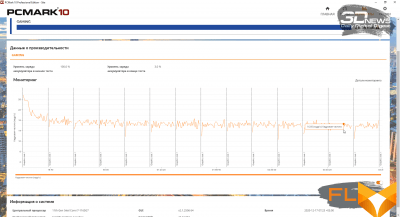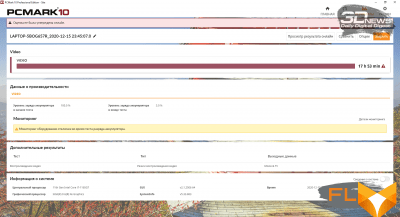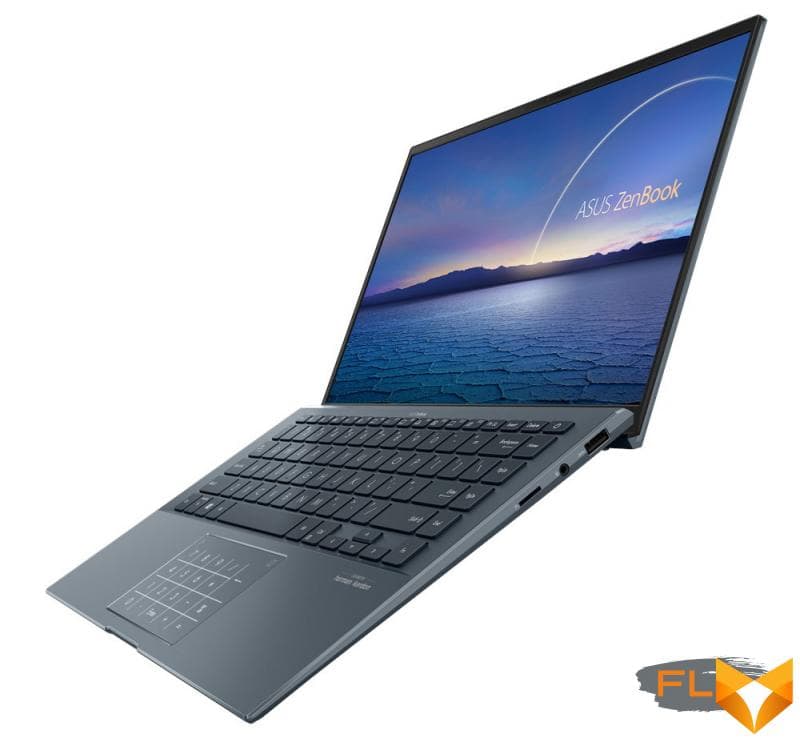


Ultrabook ExpertBook B9 B9400CEA from ASUS is positioned as a compact and lightweight model designed for corporate users. Focusing on a durable and lightweight body in a stylish and modern design, the developers have not forgotten about the information security tools that are essential for business. But still, we are primarily interested in the hardware component of the ultrabook, its performance and autonomy, because the combination of technical characteristics of the ExpertBook B9 B9400CEA has all the prerequisites to take a leading position among ultrabooks. How it will actually be – we will tell you in today’s material.
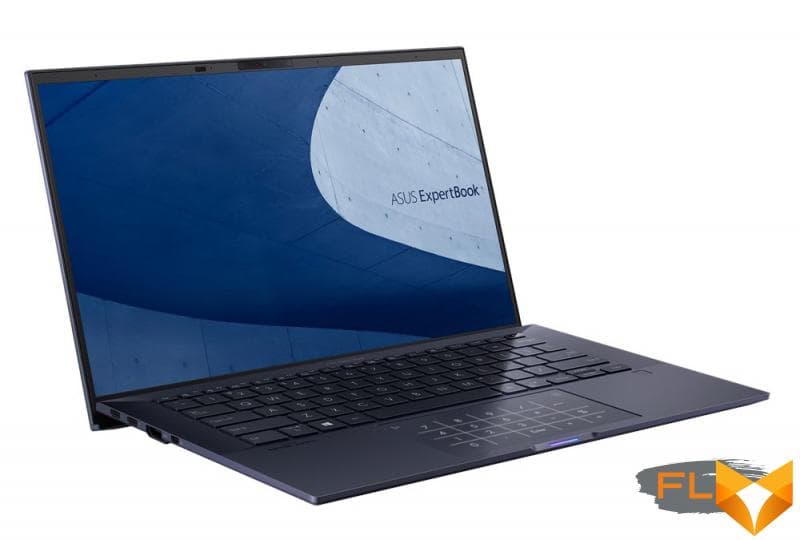
⇡#Packaging
ASUS ExpertBook B9 B9400CEA comes in a compact cardboard box with a plastic carrying handle. On the front side, only the slogan “In search of the incredible” and the name of the manufacturing company are shown.

The other sides of the box also do not shine with information content. There is only a small sticker with serial numbers and barcodes.
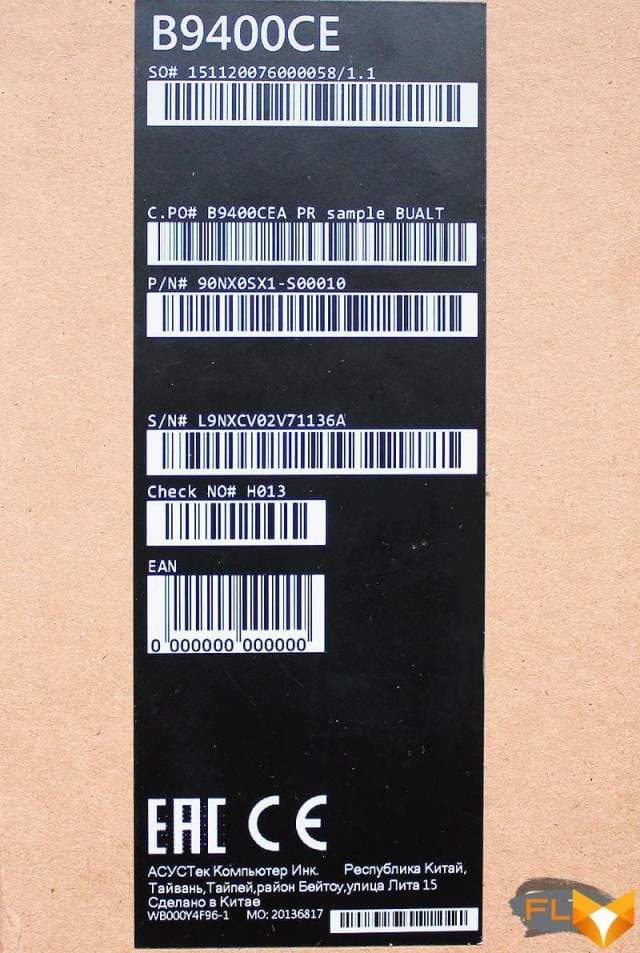
Inside the main box there is an additional box made of thick black cardboard, fixed between two polyethylene foam inserts. Next to it is another box that contains accessories and which turns into a pyramid with a wave of the hand.
 |
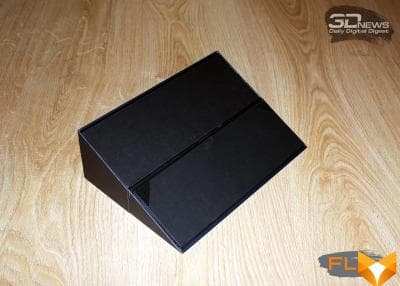 |
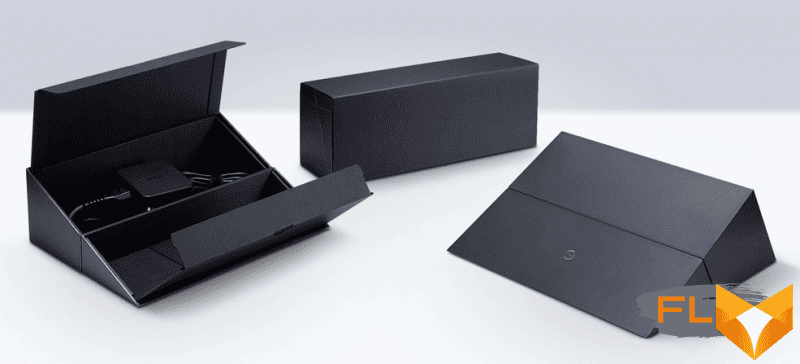
This is how ASUS kills two birds with one stone: they offer ultrabook owners a convenient stand and at the same time take care of the environment, since the owners are unlikely to throw away this box, and it is made of eco-friendly cardboard, which decomposes over time.

In our version of the ASUS ExpertBook B9 B9400CEA, only a power cable and a USB Type-C power adapter were found in the box.
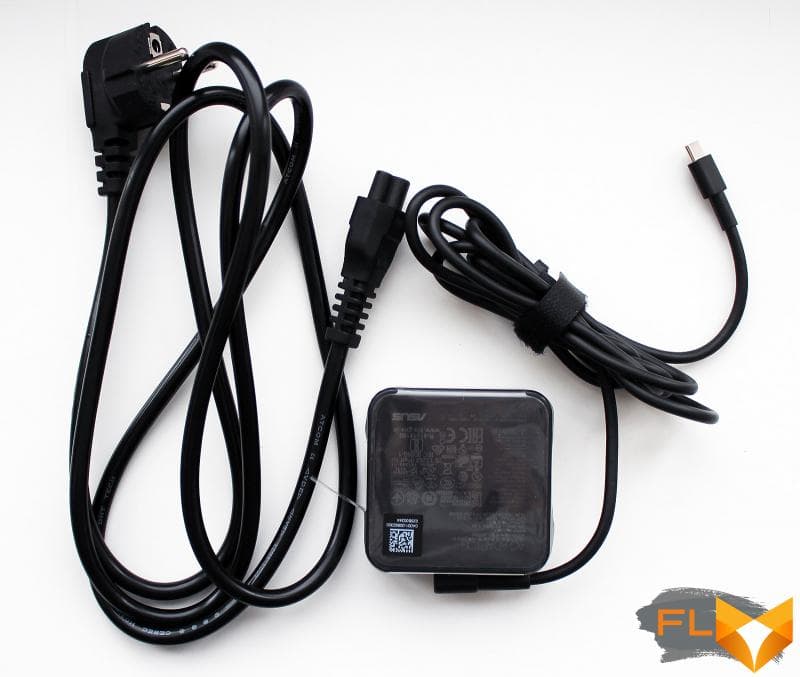
Optionally, the ultrabook can be equipped with a Micro HDMI → LAN adapter, a protective case and a Mini Dock.
ASUS ExpertBook B9 B9400CEA Made in China and comes with a 2 year warranty. We were unable to find the cost of the minimum configuration of the ultrabook, and for the maximum, as in our case, you will have to pay almost $ 3,000.
⇡#Specifications
| ASUS ExpertBook B9 B9400CEA | ||
| Processor | Intel Core i7-1165G7 (10 nm SuperFin, 4 cores/8 threads, 1.2-4.7 GHz, 12 MB L3 cache, TDP 12-28 W) Options: – Intel Core i5-1135G7 |
|
| Chipset | Intel Tiger Lake | |
| RAM | 4×8 GB LPDDR4X 4266 MHz (dual channel, 36-39-39-90 CR1) Options: – 2 x 8 GB LPDDR4X 4266 MHz; – 2 x 4 GB LPDDR4X 4266 MHz |
|
| Video subsystem | Intel processor-integrated Iris Xe Graphics | |
| Accumulators | 2 × 2TB RAID 0 from Samsung PM981 SSD (MZVLB2T0HMLB-00000), NVMe 3.0 x4 M.2 Options: – 512GB SSD; – 1TB SSD; – 2 TB SSD |
|
| Display | 14″ NanoEdge Narrow Bezel IPS Full HD (1920 × 1080) 60Hz 400nits 100% sRGB (72% NTSC) Anti-Glare | |
| Sound subsystem | Realtek ALC3288 audio codec; two stereo speakers; certification by Harman Kardon specialists; 4 microphones with Cortana and Alexa voice control |
|
| Optical drive | None | |
| Cart Reader | None | |
| Network interfaces | Cable Network | None |
| Wireless | Intel Wi-Fi 6 AX201D2W 802.11ax, MIMO 2×2, 2.4GHz and 5.0GHz (160MHz) | |
| Bluetooth | Bluetooth 5.0 | |
| NFC | None | |
| Interfaces and Ports | USB 2.0 | None |
| USB 3.2 Gen1 | None | |
| USB 3.2 Gen2 | 1 Type-A and 2 Type-C (Thunderbolt 4, up to 40Gbps) | |
| HDMI 2.0b | Yes | |
| VGA | None | |
| DisplayPort 1.4 | Yes, via USB Type-C | |
| RJ-45 | None (accessible via adapter) | |
| Microphone input | Yes (combined) | |
| Headphone Out | Yes (combined) | |
| Input Devices | Keyboard | Membrane backlit with function keys, key travel ~1.4mm |
| Touchpad | NumberPad 2.0, two-button, 105x62mm, gesture support | |
| VoIP | Webcam | HD and IR with Windows Hello |
| Microphone | Yes, 4 pcs | |
| Battery | 66 Wh (4210 mAh) 4 Cell Lithium Polymer | |
| Power adapter | AD10380 (65W, 20.0V, 3.25A), 212g, with 1.57m cable | |
| Dimensions | 320.0 × 203.0 × 14.9mm | |
| Weight without power adapter: declared/measured | 1005 / 1012g | |
| Laptop color | “Space Black” | |
| Other Features | MyASUS; ASUS Business Manager; ASUS Control Center; Wake-on-LAN Hotkeys; safe recharging |
|
| Operating system | Windows 10 Pro/Home | |
| Warranty | 2 years | |
| Retail price | $3,000 | |
⇡#Design and ergonomics body
ASUS ExpertBook B9 B9400CEA is available in a single color scheme called Space Black. In the finishing of its case, microparticles of different colors are used, selected in such a way as to create the same impression as when looking at the night sky.
 |
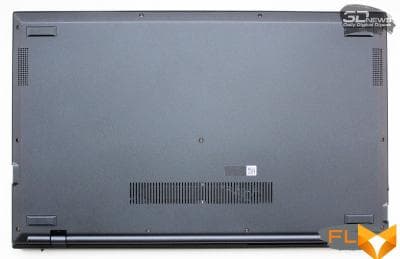 |
At the same time, the body changes color depending on the angle of view, so it is impossible to unequivocally characterize it in one word. Now it is gray, then black, then dark blue, and even iridescent with red splashes. In general, the color is a chameleon. For example, here’s what the display lid looks like with the logo at an angle of about 45 degrees.
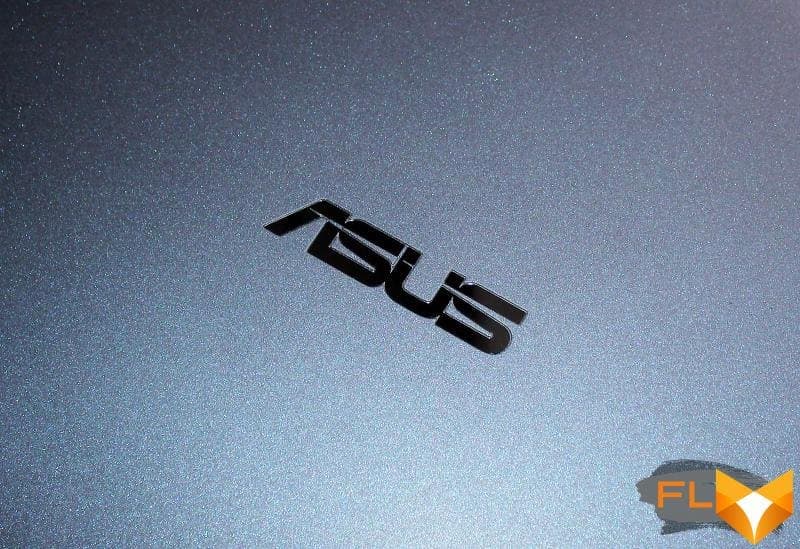
And here is how the whole ASUS ExpertBook B9 B9400CEA looks like in warm light.
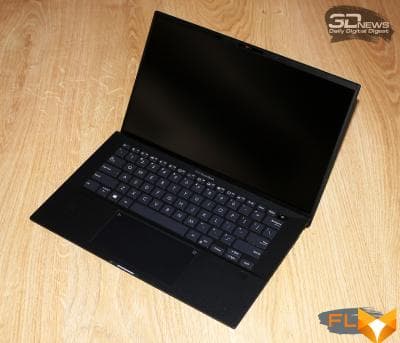 |
 |
The display cover and keyboard work surface are made of magnesium-lithium alloy, which is lightweight and very durable. Moreover, they are made not by stamping, but by high-precision processing on a milling machine. Let’s add that the dimensions of our version of the ultrabook are 320.0 × 203.0 × 14.9 mm, and it weighs only 1012 grams. Moreover, if you choose a model with a 33 Wh battery, then the weight of the ultrabook will not exceed 880 grams.
Thanks to the use of an innovative case material, ASUS ExpertBook B9 B9400CEA was able to obtain a certificate for compliance with the American military industrial standard MIL-STD-810H, and besides this, this model was subjected to a whole series of internal tests, among which there are even such as 20 hours of operation at temperatures of 50 and 0 degrees Celsius.
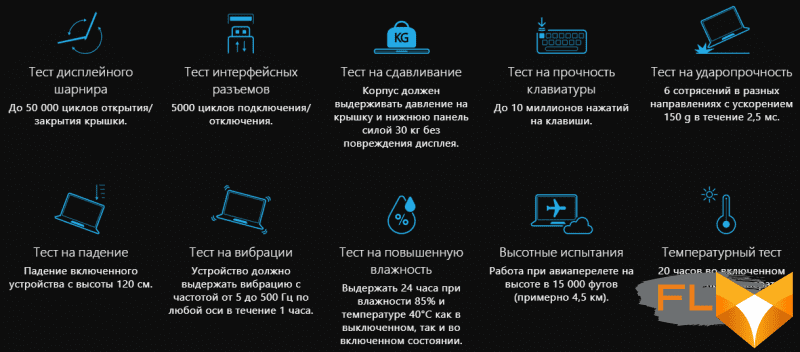
The base of the ultrabook case, made of plastic, is equipped with four rubber feet, which give the case stability and prevent it from slipping on inclined surfaces.
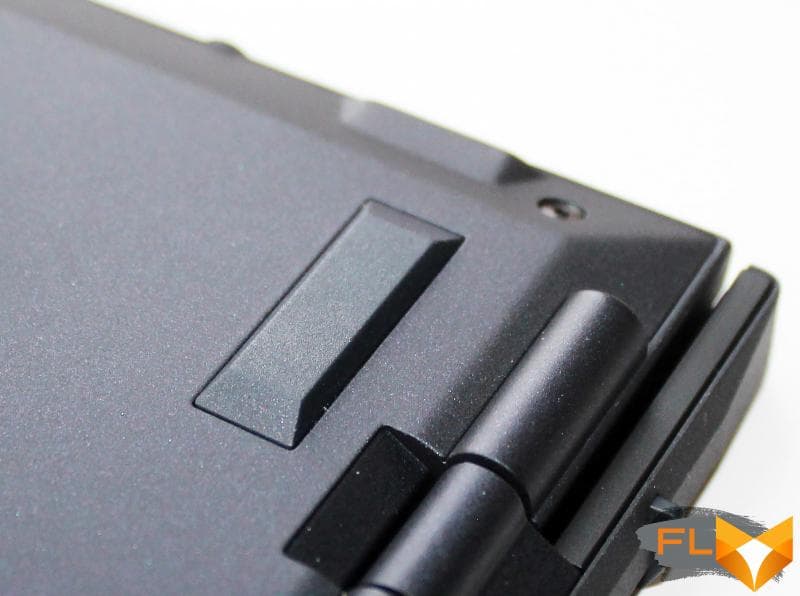
The display angle is 180 degrees, so that the ultrabook, if necessary, can be decomposed completely horizontally.
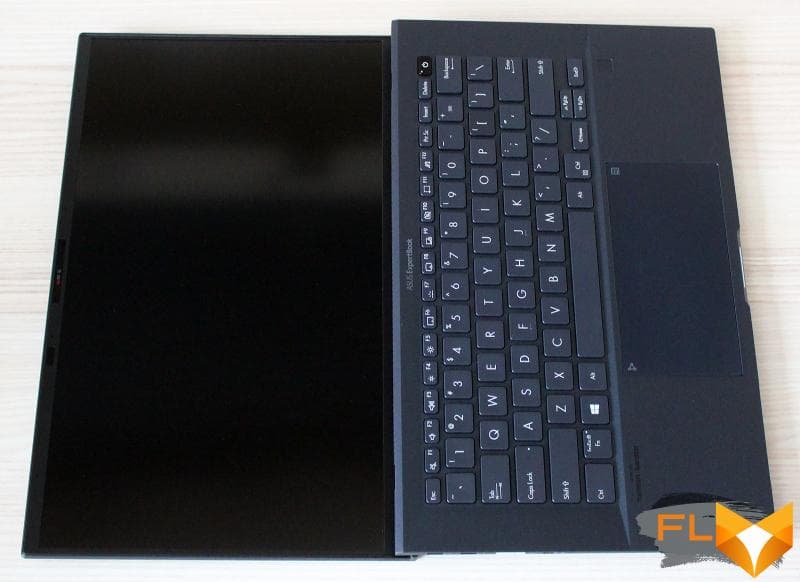
The innovative ErgoLift hinge lifts the far edge of the ultrabook’s base, tilting it 3 degrees, making keyboarding more comfortable for the hands while improving the cooling efficiency of internal components.
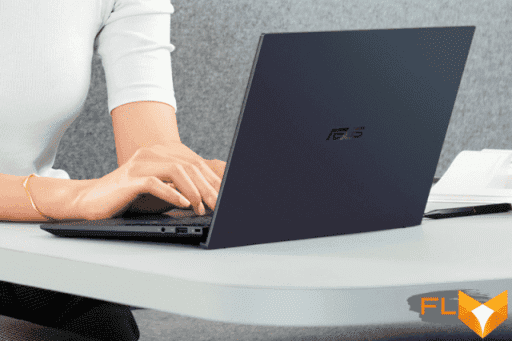
The lid locks in any position. At the same time, so that the end of the lid and the surface are not scratched during such constant openings, it is equipped with a pair of plastic stops.
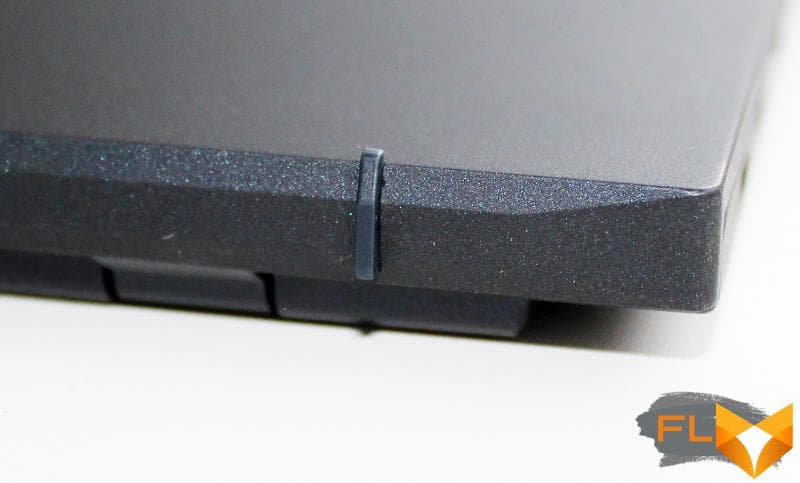
There are no connectors or ports on the front end of the ultrabook.

Only a notch is provided for a more convenient opening of the display, which, by the way, does not have to be held with the second hand. In the same notch, there is an indicator strip that signals the battery charge and the operation of the Alexa voice assistant.
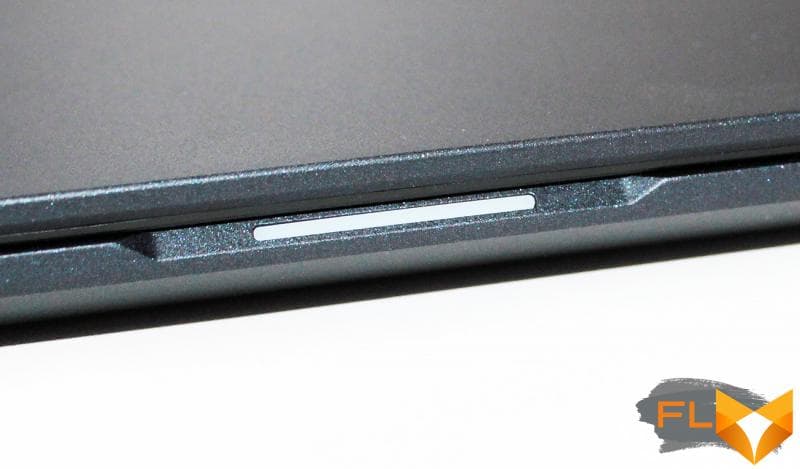
There are also no ports on the back of the ultrabook case.

All of them are located on the sides of the case.
 |
 |
On the left are two USB 3.2 Gen2 Type-C ports of the Thunderbolt 4 interface (up to 40 Gb / s) with support for the Power Delivery function, an HDMI video output and a micro-HDMI connector (you can connect a network cable to it via an RJ-45 adapter), and on the right Kensington hinge, USB 3.2 Gen2 Type-A port (10 Gb/s), headphone/microphone combo jack, and drive charge and activity indicators are displayed.
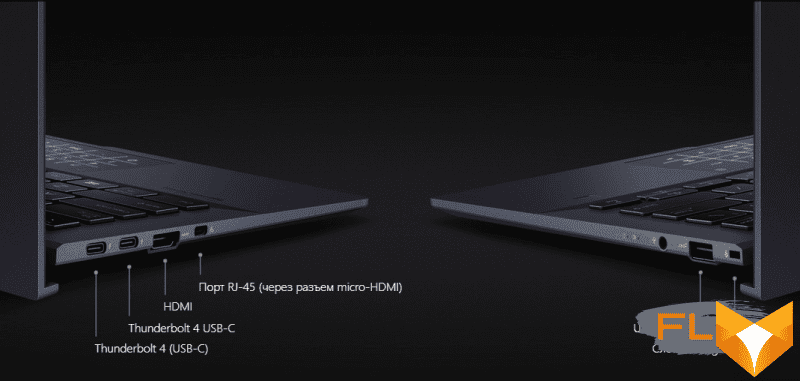
Ideally, I would also like to see a microSD card reader here, and everything else, in our opinion, the ASUS ExpertBook B9 B9400CEA has.
⇡#Input Devices
The ultrabook was equipped with a membrane-type keyboard without a block of numeric keys, and in our case, without a Russian layout. The dimensions of the main keys are 15.5 × 14.5 mm, the functional keys are 12.5 × 7.0 mm.

Both Shift keys are enlarged, as is the Enter key, but the arrows, on the contrary, are reduced – it will take a habit to use the vertical ones accurately.
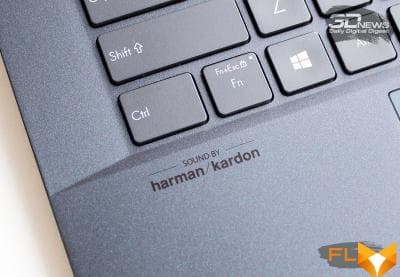 |
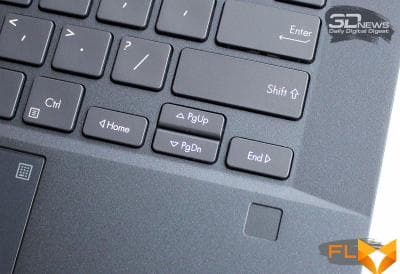 |
There is a fingerprint scanner below the arrows. In addition, the keyboard is waterproof – it can withstand up to 66 cm3 of liquid.
The laptop power button is located in the upper right corner of the keyboard – it is highlighted in a darker color. With a short press on it, like on ordinary keys, there is no operation – the ultrabook will not accidentally turn off.
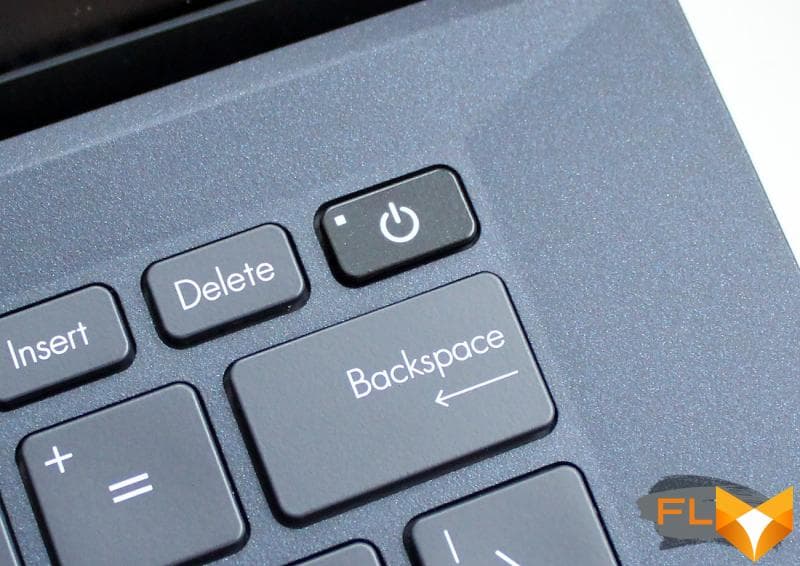
The key travel is 1.3-1.4 mm. Typing on the keyboard is comfortable, feedback is felt to a sufficient extent, while pressing is almost silent.
The keyboard has a backlight, but without brightness control – it can only be turned on or off. The key light is dim, especially compared to the NumberPad 2.0 backlight.
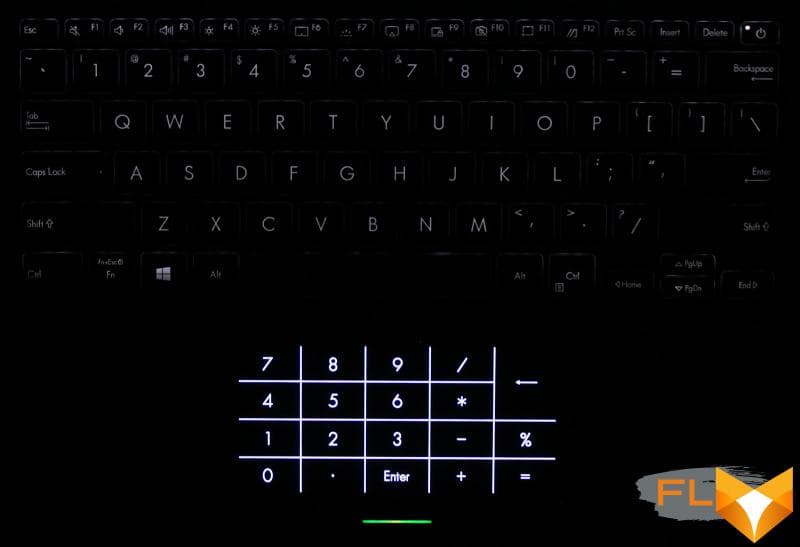
The dimensions of the latter are 105 × 62 mm.
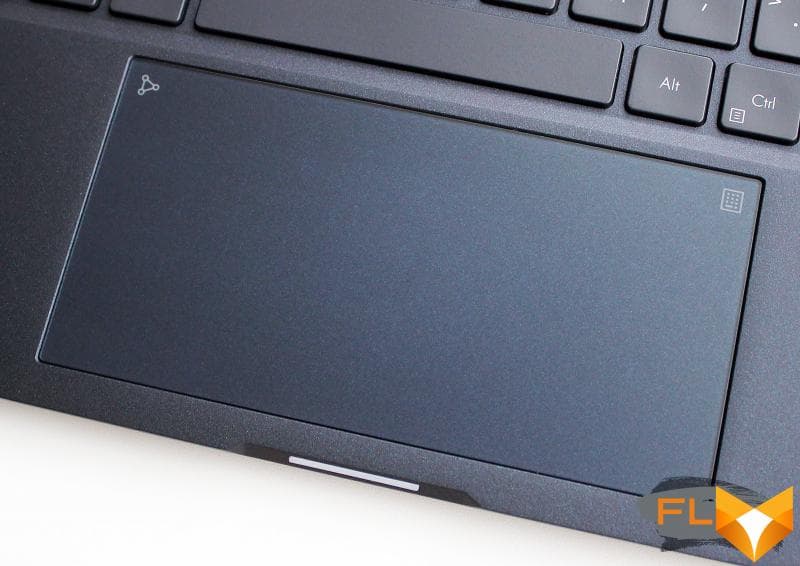
The surface of the “smart” touchpad is tactilely pleasant, the operation of the buttons is clear and without delay.
Four microphones, a proximity sensor, a camera activity indicator and the HD camera itself with a mechanical shutter are built into the top frame of the ultrabook’s 8 mm display.

Four long-range microphones support echo cancellation and intelligent noise reduction, and with the help of an IR camera and a proximity sensor, you can quickly and easily unlock the ultrabook – it can recognize the user’s face.

⇡#Display
Regardless of the hardware configuration, ASUS ExpertBook B9 B9400CEA is equipped with only one type of display: a 14-inch NanoEdge IPS matrix with Full HD resolution (1920 × 1080 pixels) and a frequency of 60 Hz. The surface is matte, anti-reflective coating is.
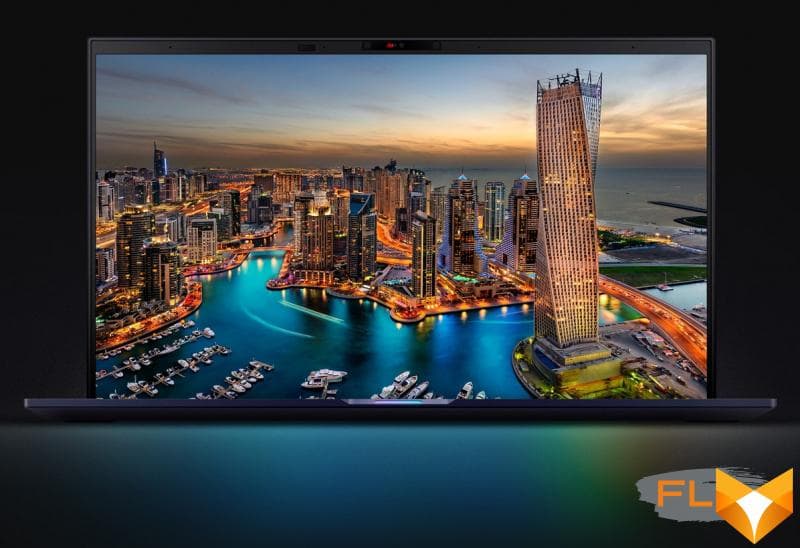
For the display, the specifications claim 100% sRGB (72% NTSC) color gamut and 400 nits of brightness.
Matrix manufacturer – AU Optronics (marking – AUOA48F).
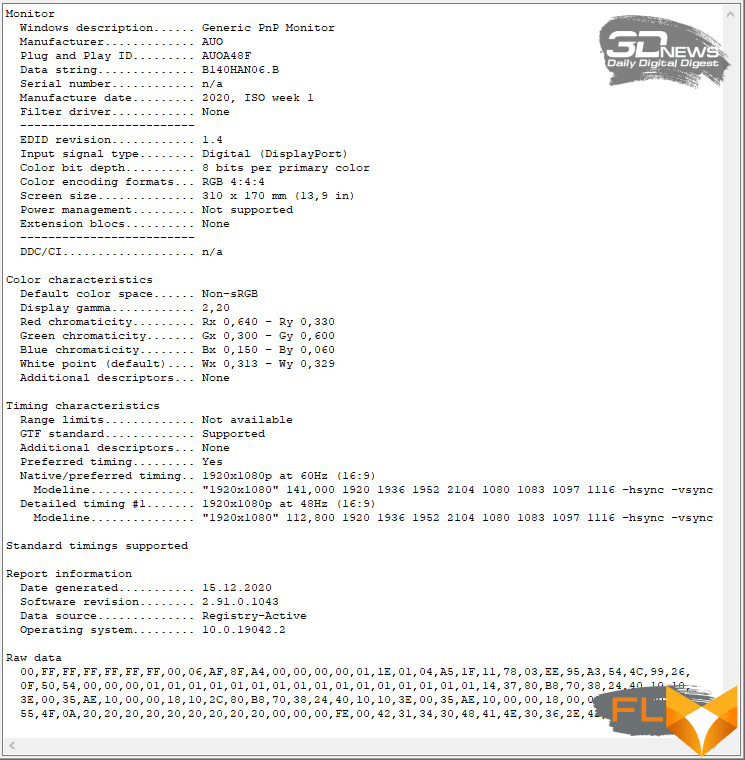
We tested the Ultrabook’s display with an X-Rite i1 Display Pro calibrator and Argyll CMS software with a DispcalGUI graphical interface. All measurements were taken prior to display calibration. Let’s look at the results.

The color temperature of the ultrabook display is as close as possible to the reference value of 6500 K, and its stability is amazing.
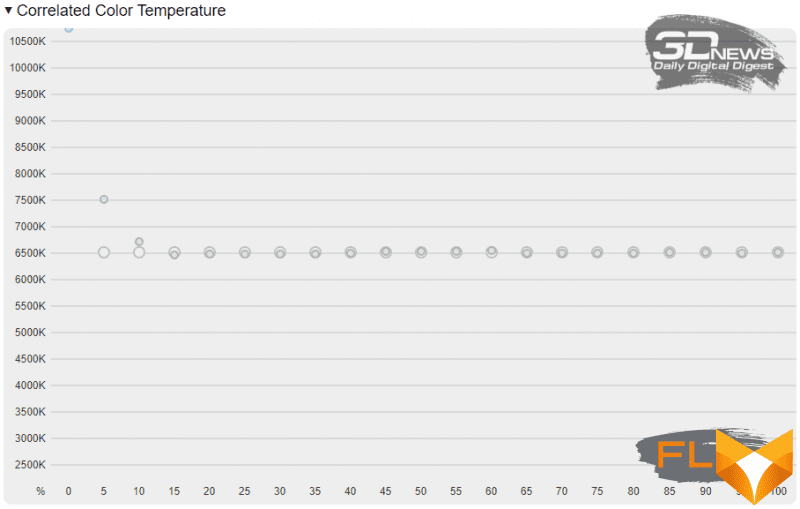
With the gamma curve, the situation is no longer so ideal, but there are no serious deviations.
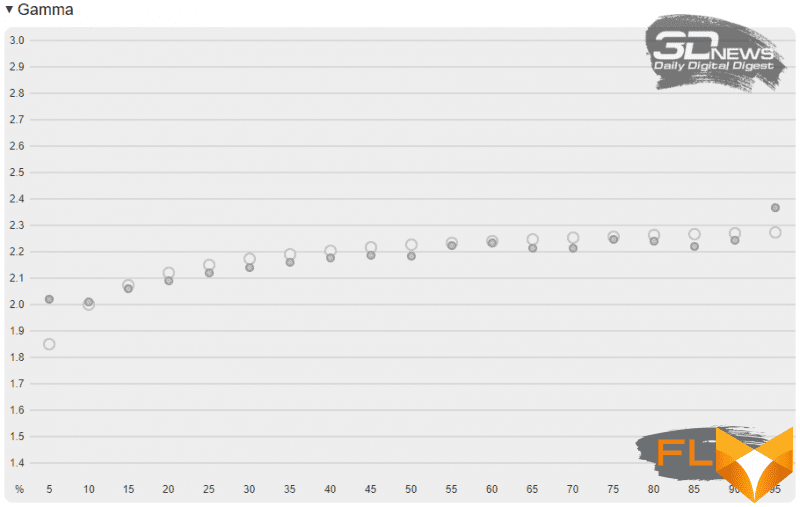
But the almost perfect color balance in the gray gradient tells us about a fairly high-quality display calibration at the factory.
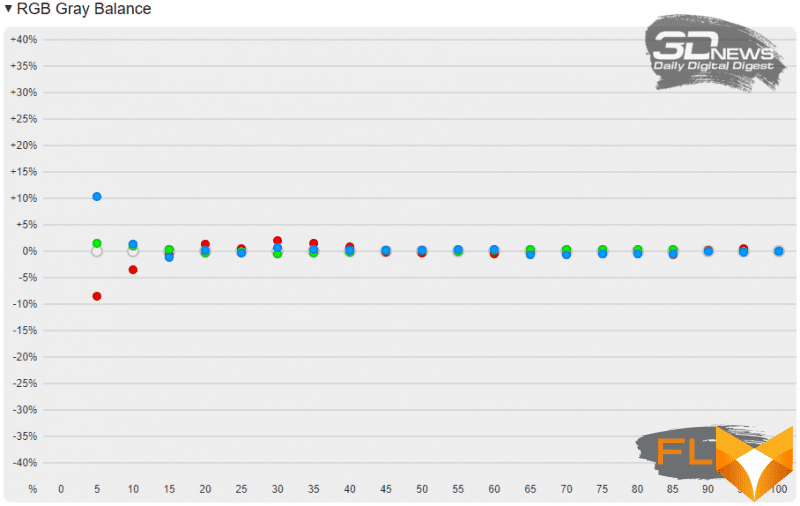
The ASUS ExpertBook B9 B9400CEA’s Delta E hue fidelity test passed with a large margin for all hues.
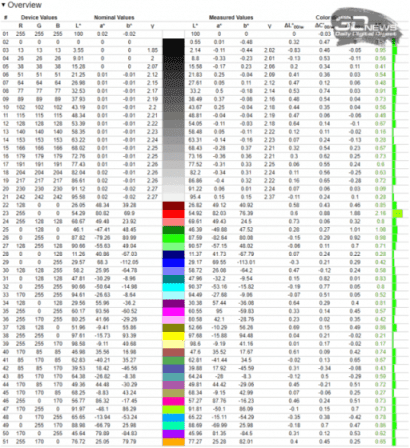
After calibration, the average level of deviations was a miserable 0.08 units, and the maximum – 0.64 units. Coverage of the sRGB color space exceeded 100%.
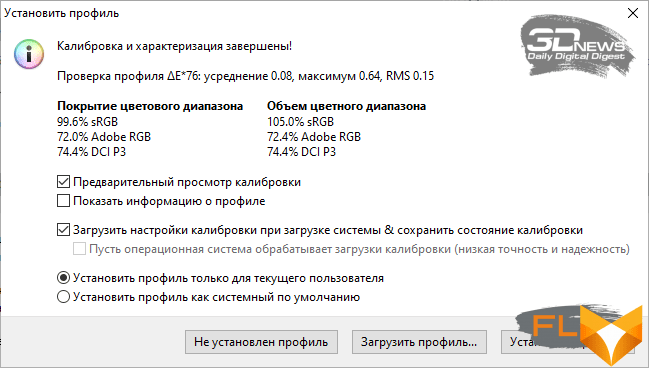
The maximum display brightness was 385 cd/m2 and the minimum was 19 cd/m2.
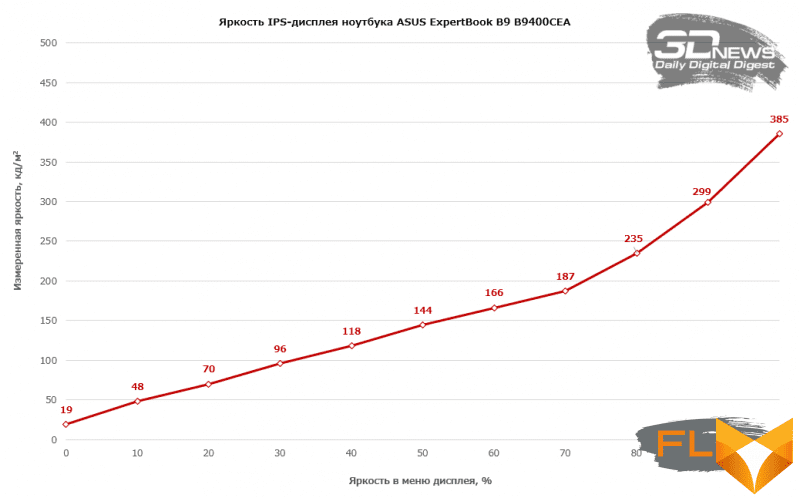
Both are excellent values, the brightness margin here is sufficient for working with an ultrabook on a bright sunny day.
As for the display backlight uniformity, measured at a manually set brightness level of 200 cd/m2, the problem was found only in the lower left corner of the display.
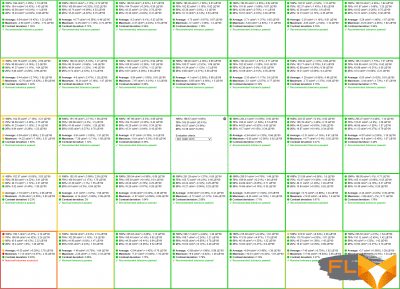 |
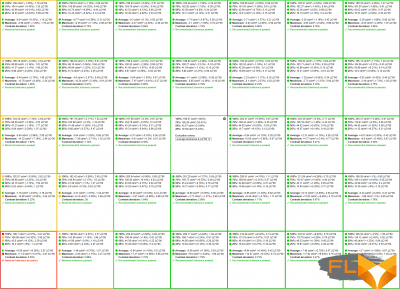 |
However, during normal work with a laptop, we could not notice it.
Based on the test results and subjective impressions of the author of these lines, we can confidently rate the ASUS ExpertBook B9 B9400CEA display as “excellent”! Of the ASUS ultrabooks, only the premium ZenBook Flip S UX371EA transformer had a better screen, which, recall, uses an OLED matrix.
At the end of the screen tests, let’s mention the ability to adjust the color gamut of the display from the MyASUS application.
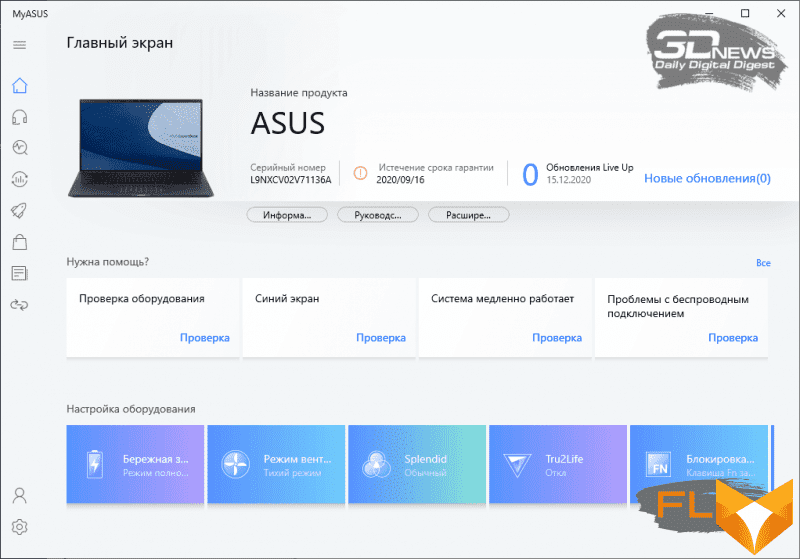
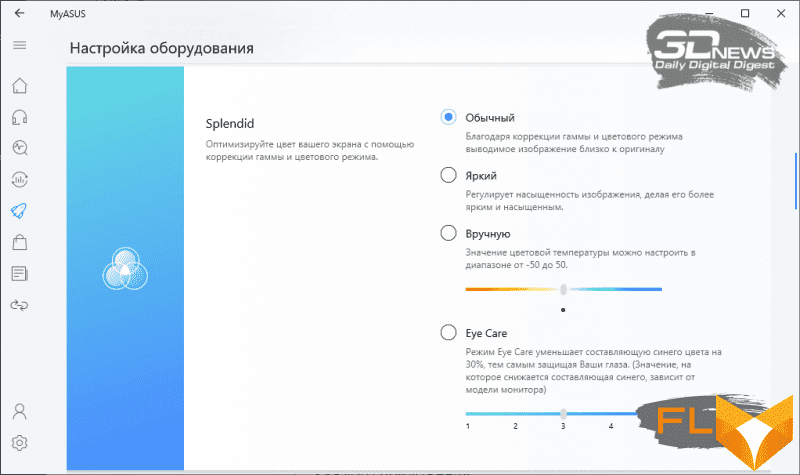
Another interesting feature of the ultrabook, which would be appropriate to talk about here, is the ability to integrate a computer with a smartphone using the proprietary application Link to MyASUS.
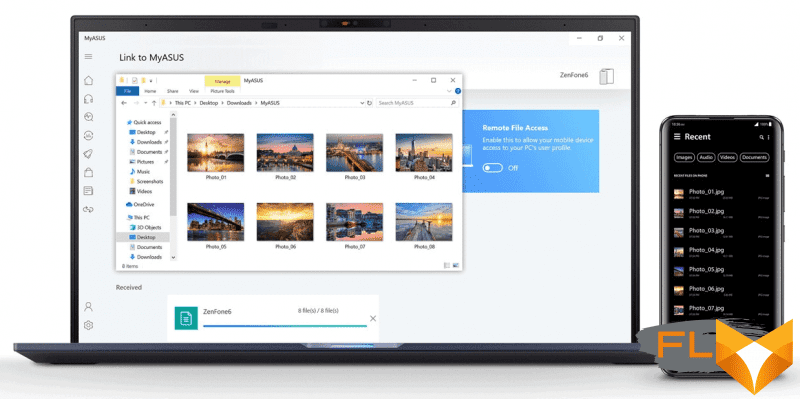
This feature allows you to transfer files in both directions, make calls, duplicate or expand the screen, and much more.
⇡#Internal device and accessories
The modest dimensions of the ExpertBook B9 B9400CEA did not prevent ASUS engineers from fitting a very productive hardware configuration into it. Perhaps even the most productive, which we have seen in devices the size of a glossy magazine. Moreover, less than half of the internal volume is allocated to the board with components, and the battery takes up most of it.
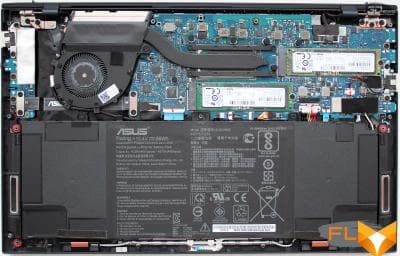 |
 |
The AIDA64 Extreme utility will demonstrate the main components, and then we will analyze each of them individually.
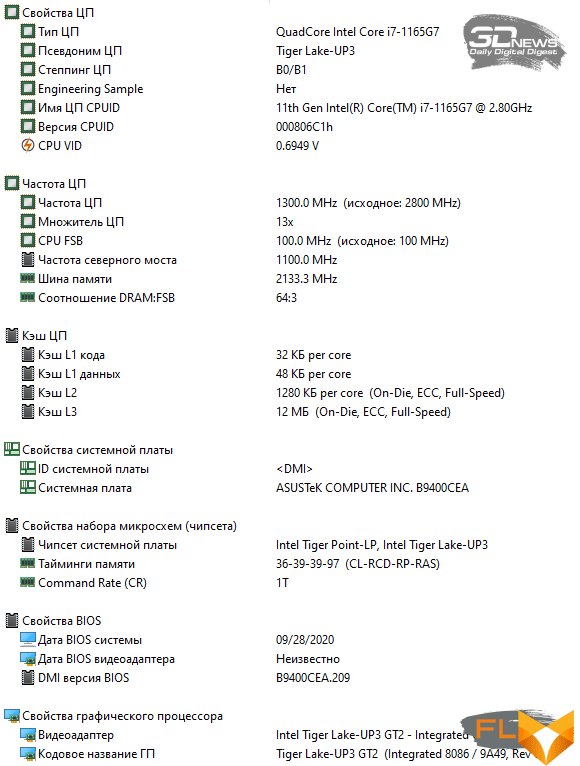
The ultrabook is based on an Intel Tiger Lake chipset motherboard, the BIOS of which we updated to the latest version – 209 from September 28, 2020.
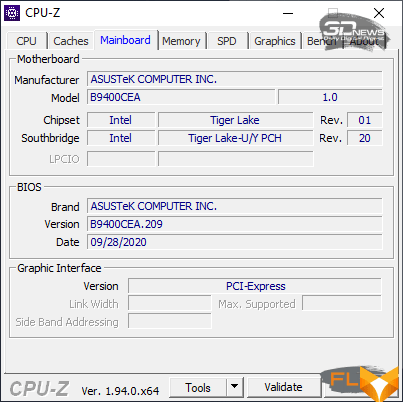
At the time of writing this article, this BIOS version is still the last one available.
For the ASUS ExpertBook B9 B9400CEA, two variants of the 11th generation Tiger Lake-U family processors have been prepared: Intel Core i5-1135G7 or Intel Core i7-1165G7. They differ only in turbo frequency (4.2 and 4.7 GHz), L3 cache (8 and 12 MB) and the number of shader processors of the integrated graphics core (80 and 96). All other characteristics of these processors are the same. Our version of the ultrabook has an older processor model.
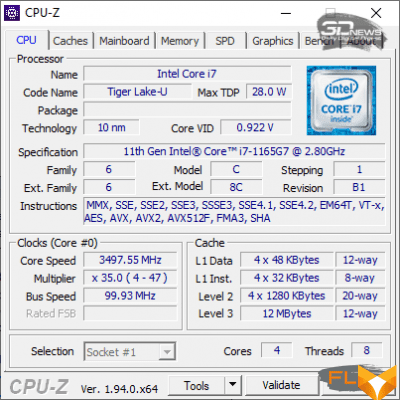 |
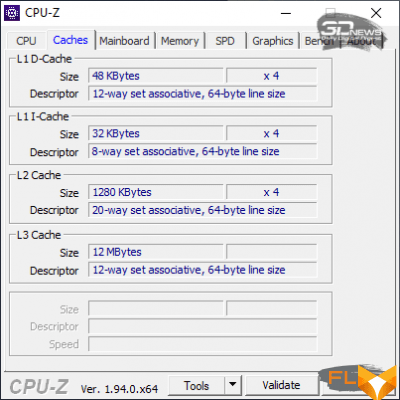 |
This is not the first or even the third time we are testing ultrabooks with this processor, but we still recall that its maximum TDP level is declared at around 28 W, and the base is a modest 12 W.
The ASUS ExpertBook B9 B9400CEA can be soldered with 8, 16 or 32 gigabytes of LPDDR4X RAM operating in dual-channel mode at a frequency of 4266 MHz. Since we have a flagship version on tests, the amount of ultrabook memory in it is the maximum.
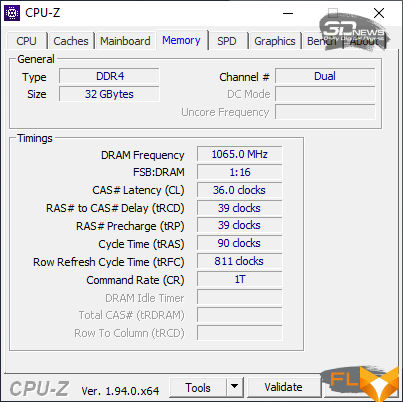
The main timings of such memory are very high: 36-39-39-90_1T.
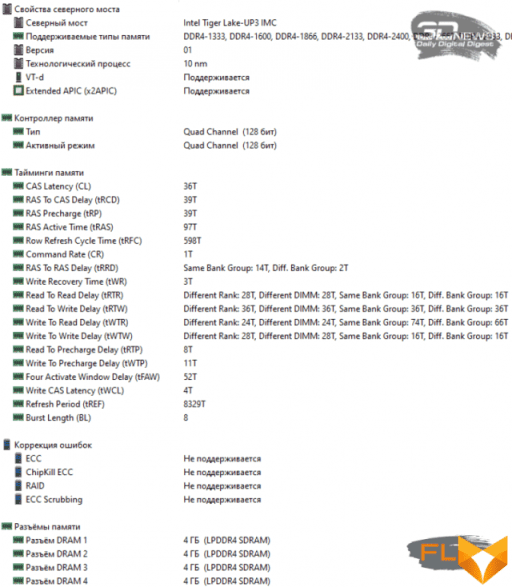
However, according to the RAM bandwidth tests that you will see in the testing section, this is still the fastest memory that is found in ultrabooks (and laptops too, including gaming models).
There is no discrete graphics card in the ultrabook, so you will have to be content with only the modest capabilities of the Intel Iris Xe graphics core built into the central processor.
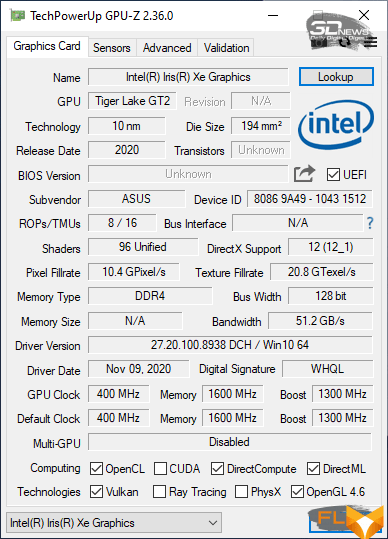
However, it is unlikely that corporate laptops that do not belong to the class of workstations require something more productive.
Officially, the amount of drives in an ultrabook can be 512 GB, 1 TB or 2 TB, and in the latter case, the volume is collected by two drives with a capacity of 1 TB each in RAID 0 mode. But the most interesting thing is that the ultrabook provided to us for tests has two NVMe PCIe 3.0 x4 – drive with a capacity of 2 TB each. They also work in RAID 0.
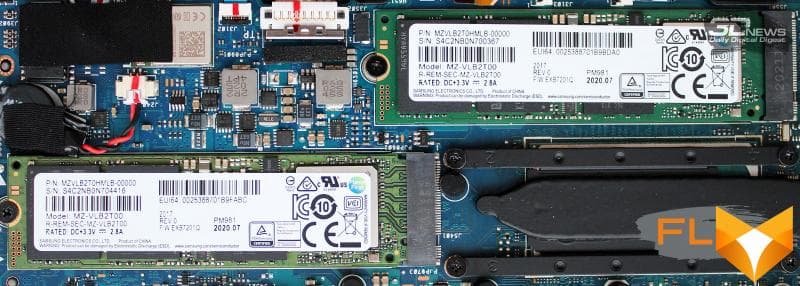
Of course, the drives are exactly the same – the Samsung PM981 (MZVLB2T0HMLB-00000) models, only for some reason with a different textolite color. By the way, each such drive costs from $300, so it’s not surprising that the resulting price of ASUS ExpertBook B9 B9400CEA is so high.
 |
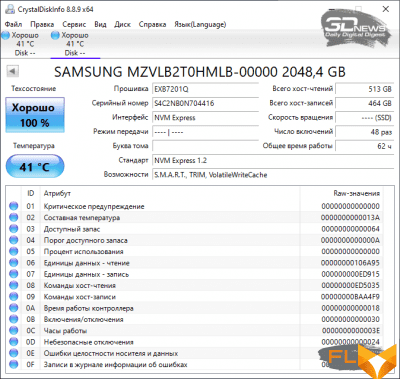 |
We were not impressed with the performance indicators of such a four-terabyte array – the same benchmark results can be demonstrated by one Samsung PM981. But such a disk array is equally fast both when the ultrabook is running from the mains, and when running from the battery.
|
ATTO Disk Benchmark (power grid) |
ATTO Disk Benchmark (battery) |
|
AS SSD Benchmark (grid) |
AS SSD Benchmark (battery) |
|
CrystalDiskMark (power grid) |
CrystalDiskMark (battery) |
Another not very pleasant surprise was presented to us by the disk subsystem in the temperature tests. If during normal laptop operation the temperature of the SSD does not rise above 50 degrees Celsius, then in the SSD stress test one drive warmed up to 90 degrees Celsius when the ultrabook was running on mains power and up to 76 degrees Celsius when running on battery power. We do not rule out that this problem is characteristic only of a tested engineering sample, and we hope that it will not manifest itself in serial devices, but unfortunately we cannot verify this.
|
SSD stress test on AC power |
SSD Stress Test on Battery |
Most likely, these results were affected by the proximity of the SSD memory chips to the heat pipe that cools the processor, therefore, given the poor speed performance of the RAID array, it is probably better not to combine these SSDs into a zero RAID level.
Despite the fact that there is no RJ-45 connector on the sides of the laptop, the ASUS ExpertBook B9 B9400CEA still provides a wired network connection – via a Micro-HDMI → RJ-45 adapter, and the Intel AX201D2W module with Wi-enables is responsible for wireless network connections in the ultrabook. -Fi 6 (802.11ax), 2×2 MIMO and 2.4GHz and 5.0GHz capability (160MHz bandwidth).
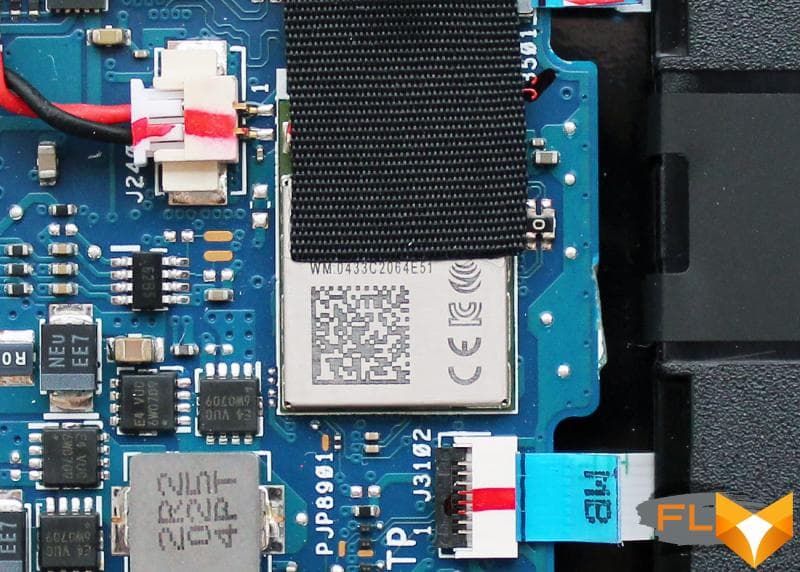
The antennas of the wireless module are located in the front of the ultrabook case.
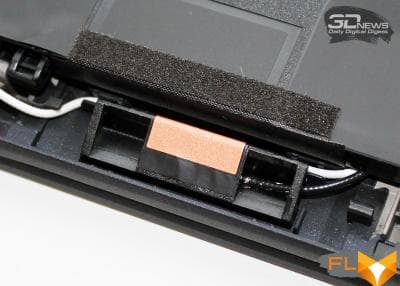 |
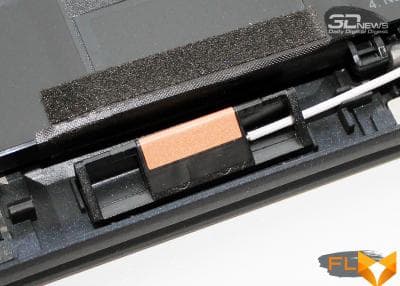 |
MyASUS has a TaskFirst utility that allows you to allocate network bandwidth among applications and prioritize them.
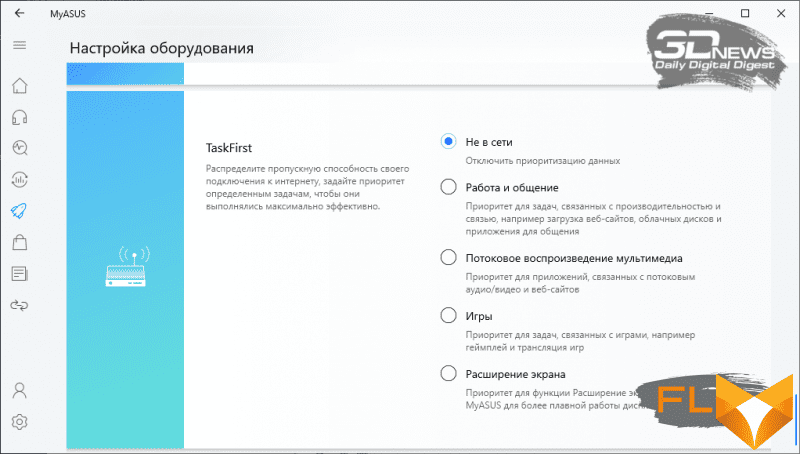
The sound system is based on the Realtek ALC3288 audio processor.
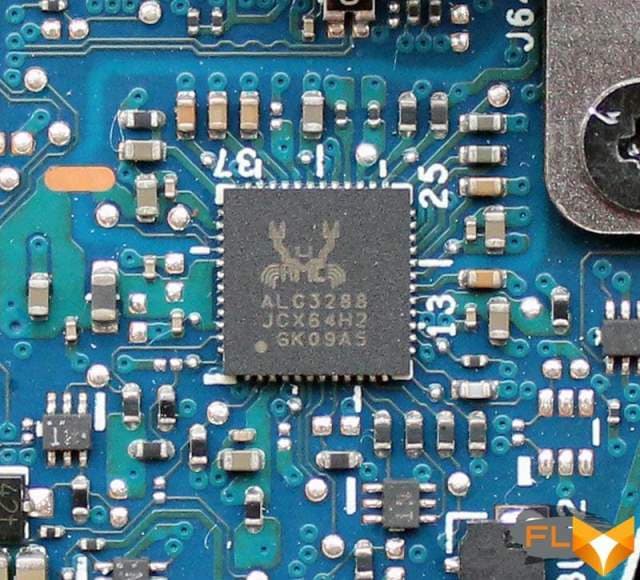
Experts from Harman Kardon helped to adjust the output of the ASUS sound range, who then certified this audio system. Two stereo speakers are built into the bevels of the sides of the case.
 |
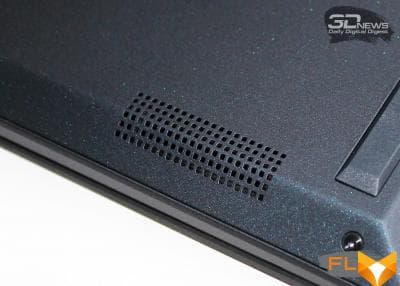 |
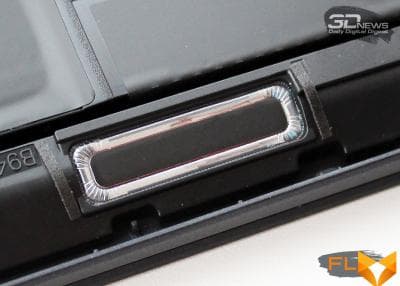 |
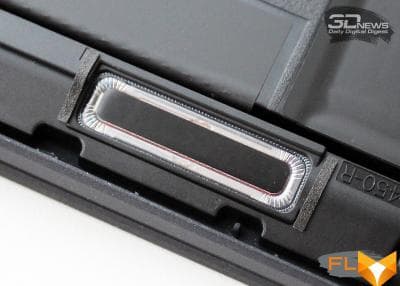 |
Believe it or not, the little ExpertBook B9 B9400CEA sounds impressive. Very accurate and clear reproduction of the audio sequence is possible throughout the entire volume range, and you will not hear any wheezing here even at maximum power. Of course, there is not enough low frequencies, but – with a discount for size – the output is simply outstanding sound for an ultrabook.
⇡#Cooling system, efficiency and noise level
Air enters the ultrabook’s cooling system from below through the ventilation grill at the base, and is ejected through the rear end.
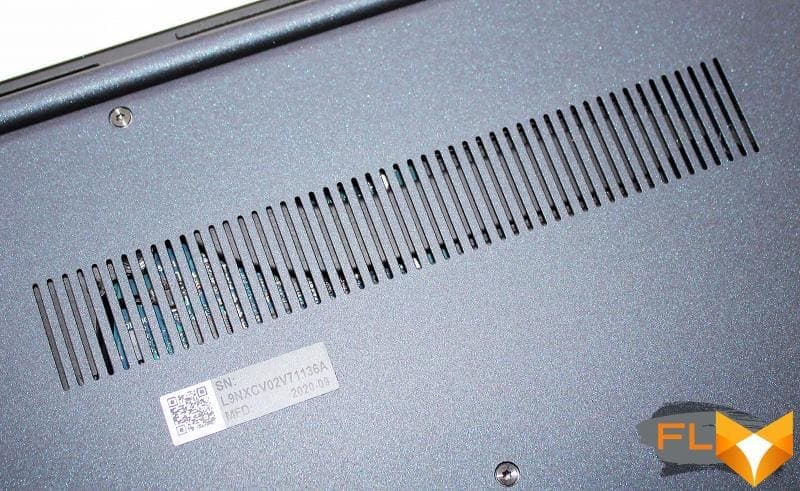

A single 10mm heatpipe extends from the processor, transferring heat to the heatsink, which is cooled by a fan.
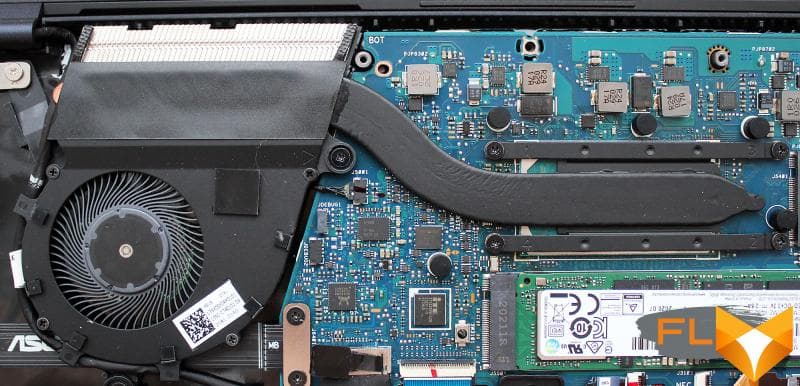
The operating modes of the ultrabook and its cooling system are regulated in the MyASUS application, where three options are available: high performance, standard and quiet.
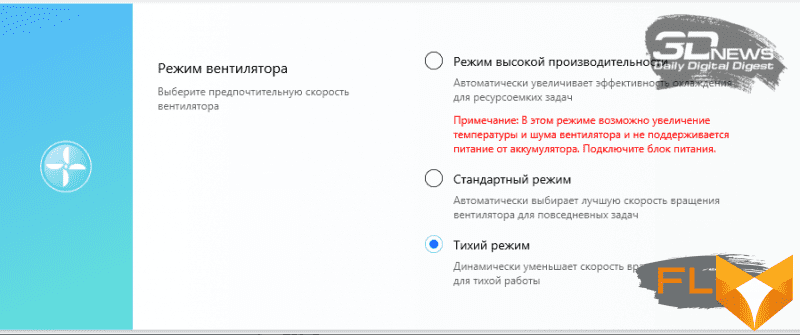
To evaluate the efficiency of CPU cooling in the ultrabook, we used the powerMAX utility (in AVX mode), and the monitoring parameters were read and displayed by HWiNFO64. Testing was conducted at an indoor temperature of approximately 24.5 degrees Celsius, running the Windows 10 Pro x64 operating system with the latest available drivers and updates installed.
We first tested the ASUS ExpertBook B9 B9400CEA on AC adapter and mains power.
|
Performance |
Balanced |
Silent |
In maximum performance mode, the processor frequency stabilizes at 2.9 GHz with the temperature of the hottest core around 92 degrees Celsius. At the same time, the tangential fan of the cooling system is clearly audible, but this noise can hardly be called loud. In balanced mode, the CPU frequency is lower by 0.4 GHz and is 2.5 GHz, but the laptop periodically resets it to 0.9 GHz. Temperatures here do not exceed 80 degrees Celsius, and there is practically no noise. Finally, the ultrabook’s quiet mode periodically allows the processor to boost up to 2.6 GHz, but most often it runs at 1.0-1.2 GHz, at a temperature of about 60 degrees Celsius. But it is in this mode that the ultrabook is silent.
When running on battery, the results were different, as you would expect.
|
Performance |
Balanced |
Silent |
So, the maximum performance mode stabilizes the processor frequency at 2.4-2.5 GHz at temperatures of about 80 degrees Celsius and a TDP level of no more than 21 watts. In balanced mode, the frequency is 0.1-0.2 GHz lower at the same temperatures and 18-watt processor TDP. But in quiet mode, the ultrabook works exactly the same as on the power adapter, there are no changes in frequencies or temperatures.
Performance testing
Since ASUS ExpertBook B9 B9400CEA is designed primarily for extended mobile work without plugging into a power outlet, in addition to the usual tests at the maximum level of performance, we tested its capabilities in a balanced battery mode. The results are shown below in the form of screenshots.
|
AIDA64 Extreme memory and GPGPU test (power grid) |
AIDA64 Extreme memory and GPGPU test (battery) |
|
WinRAR (power grid) |
WinRAR (battery) |
|
7-Zip (power grid) |
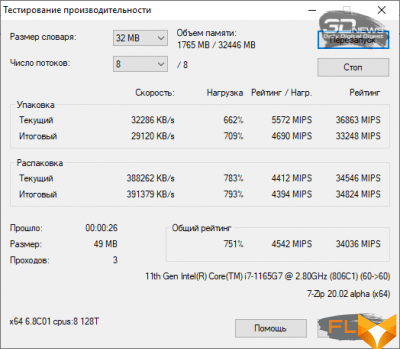
7-Zip (аккумулятор) |
|
HandBrake (power grid) |
HandBrake (battery) |
|
Cinebench R20 (power grid) |
Cinebench R20 (battery) |
|
Cinebench R23 (power grid) |
Cinebench R23 (battery) |
|
Blender 2.91.0 classroom (power grid) |
Blender 2.91.0 classroom (battery) |
|
Geekbench 5 (power grid) |
Geekbench 5 (battery) |
|
PCMark’10 (power grid) |
PCMark’10 (Battery) |
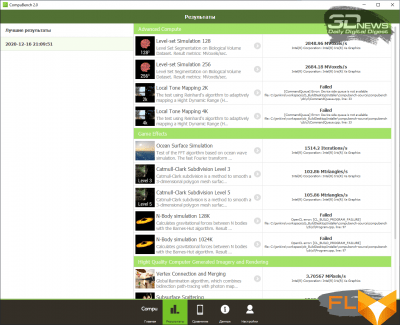 |
 |
|
CompuBench 2.0 (power grid) |
CompuBench 2.0 (battery) |
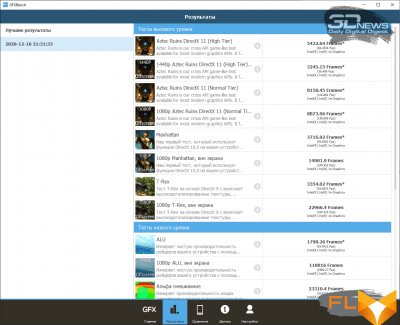 |
 |
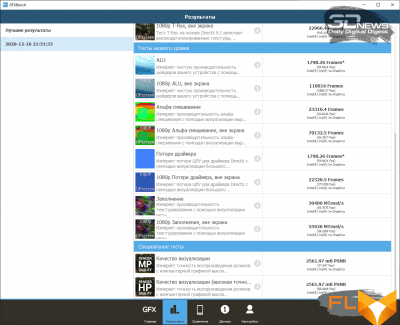
GFXBench 5 (power grid) |
GFXBench 5 (Battery) |
|
3DMark Night Raid (power grid) |
3DMark Night Raid (Battery) |
|
3DMark Fire Strike (power grid) |
3DMark Fire Strike (Battery) |
|
3DMark Wild Life (power grid) |
3DMark Wild Life (Battery) |
|
World of Tanks enCore RT (power grid) |
World of Tanks enCore RT (battery) |
As you can see, the performance of the ultrabook decreases when the power adapter is disconnected (on average, we got about minus 20%), but it remains quite sufficient for everyday work tasks, for which, in fact, the ExpertBook B9 B9400CEA was developed.
Below in the table we present the results obtained in the benchmarks of the ExpertBook B9 B9400CEA in comparison with the achievements of another compact ASUS model – ZenBook 14 Ultralight UX435EGL with the same Intel Core i7-1165G7 processor, as well as the Honor MagicBook 14 ultrabook (NblL-WDQ9HN) with a six-core AMD processor Ryzen 5 4500U.
| Test Name | Indicator | ASUS ExpertBook B9 B9400CEA (Intel Core i7-1165G7) |
Honor MagicBook 14 (NblL-WDQ9HN) (AMD Ryzen 5 4500U) |
ASUS ZenBook 14 Ultralight UX435EGL (Intel Core i7-1165G7) |
|
| October 2020 | September 2020 | September 2020 | |||
| AIDA64 memtest | Read | ↑ | 63978 | 32552 | 63983 |
| Write | ↑ | 66 785 | 31455 | 66 761 | |
| Copy | ↑ | 65 284 | 28 215 | 64889 | |
| Latency | ↓ | 91.7 | 97.3 | 87.5 | |
| WinRAR | KB/s | ↑ | 10 767 | 6812 | 10997 |
| 7-Zip | MIPS | ↑ | 41 751 | 36571 | 39293 |
| HandBrake | H.265 MKV 4K, s | ↓ | 756.22 | 595.81 | 767.94 |
| CineBench R20 | CPU (Multi Core), pts | ↑ | 2032 | 2278 | 1977 |
| CPU (Single Core), pts | ↑ | 564 | 445 | 551 | |
| CineBench R23 | CPU (Multi Core), pts | ↑ | 5 256 | 5 792 | 5 192 |
| CPU (Single Core), pts | ↑ | 1 474 | 1 131 | 1 429 | |
| Blender (Classroom) | Classroom, time | ↓ | 0:22:51 | 0:21:30 | 0:25:48 |
| Geekbench 5 | Single-Core Score | ↑ | 1 565 | 1 098 | 1 527 |
| Multi-Core Score | ↑ | 5 703 | 4 676 | 5 241 | |
| PCMark’10 | Total | ↑ | 5 001 | 4 773 | 5 428 |
| Essentials | ↑ | 10 068 | 8 517 | 9 094 | |
| Productivity | ↑ | 6 798 | 7 512 | 8 916 | |
| Digital Content Creation | ↑ | 4 961 | 4 612 | 5 353 | |
| 3DMark | Night Raid | ↑ | 17 697 | 10 505 | 17 149 |
| Fire Strike | ↑ | 5 291 | 2 381 | 4 156 | |
| Wild Life | ↑ | 13 444 | 5 086 | 11 273 | |
| World of Tanks enCore RT (average quality) | Score | ↑ | 12744 | 8865 | 20 106 |
| CompuBench 2.0 (Cuda) |
Level-set Sim. 256, MVoxels/s | ↑ | 2684.2 | – | 2243.9 |
| Ocean Surface Sim., It./s | ↑ | 1514.2 | – | 836.0 | |
| TV-L1 Optical Flow, Mpixels/s | ↑ | 15,495 | – | 10,939 | |
| GFXBench 5 (DX11) |
Aztec Ruins (High Tier), Frames | ↑ | 5422.64 | 2,140.74 | 4518.66 |
| ALU, Frames | ↑ | 1,798.26 | 4,548.88 | 1800.46 | |
| Render Quality, mB PSNR | ↑ | 2561.97 | 4,454.73 | 2493.75 | |
Both ASUS ultrabooks practically do not differ in performance in these tests, which is quite logical, but Honor MagicBook 14 lags behind them in memory and archiver tests, as well as in 3D benchmarks conditional for integrated graphics. However, in multi-threaded tests such as HandBrake, both CineBench and Blender, it scores slightly better.
⇡#Standalone
The ASUS ExpertBook B9 B9400CEA comes with a compact 65W (20.0V, 3.25A) AD10380 power adapter weighing 212 grams along with a built-in 1.57 meter cable.
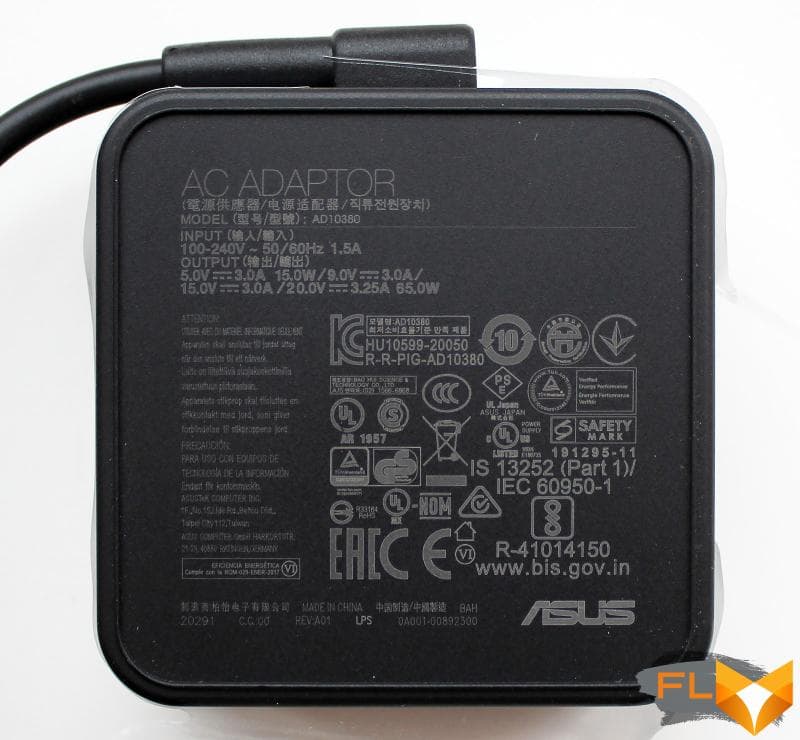
The capacity of the lithium-polymer battery in the ultrabook is 66 Wh (4210 mAh).
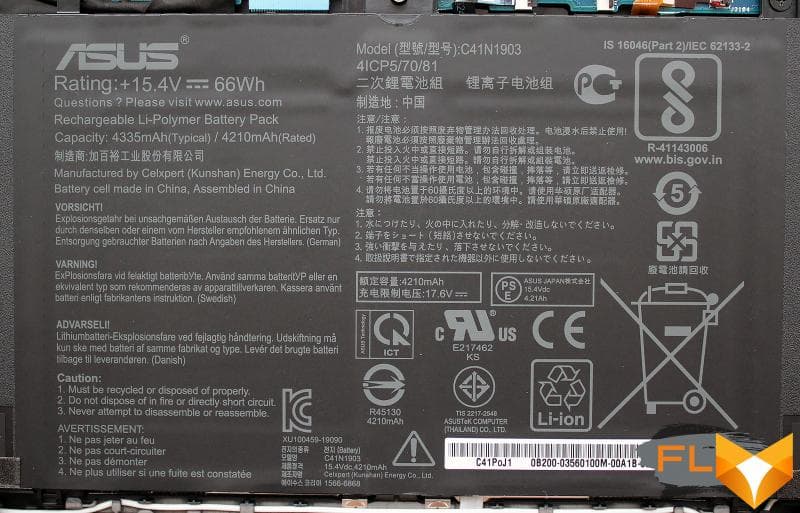
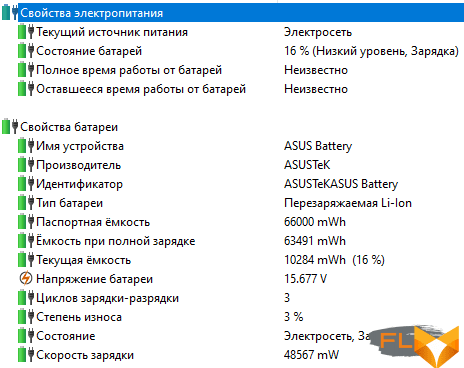
We performed four cycles of a nearly full battery charge from 3% to 99%, determining an average charge time of 2 hours 10 minutes. At the same time, it charges up to 60% in just 45 minutes (the manufacturer says about 39 minutes, but we could not achieve such an indicator). By the way, MyASUS has three battery charge modes: to full capacity, balanced and maximum life mode.
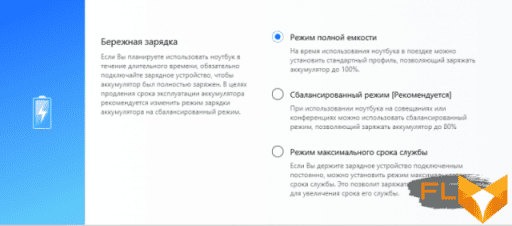
To prolong the life of your ultrabook, ASUS recommends using its battery in a balanced mode, when its charge level does not exceed 80%.
Autonomy is another strong point of the ASUS ExpertBook B9 B9400CEA. The combination of an energy-efficient Intel processor and a capacious battery allowed the ultrabook developers to claim 20 hours of battery life when playing video content and 13 hours of web surfing. Despite the fact that we did not achieve 20 hours of autonomy from the ultrabook, the numbers were still very impressive. In PCMark’10’s Modern Office, Applications, Gaming, and Video test modes, with a display brightness of 200 cd/m2, the ultrabook was able to lasted almost 18 hours of video playback, 16 and a half hours in the Modern Office test, about 15 and a half hours of everyday work emulation, and provided almost 4 hours of gaming load.
|
PCMark’10 Modern Office (16h26) |
PCMark’10 Applications (15h 41m) |
|
PCMark’10 Gaming (3 hours 46 minutes) |
PCMark’10 Video (17h53) |
In fact, these are record figures for ASUS ultrabooks and most other compact models, and when the display brightness is reduced to the level of 100 cd/m2, the battery life will increase even more.
⇡#Conclusion
Ultrabook ASUS ExpertBook B9 B9400CEA is perfect for corporate tasks – it is a compact and lightweight computer for business with sufficient performance for normal tasks and a very high level of autonomy. It has a neat and stylish body, a noble color with shimmering blotches, a comprehensive set of interfaces and security tools, a bright and perfectly tuned anti-glare display, impressive sound clarity, a comfortable keyboard and NumberPad 2.0.
In terms of hardware configuration, the ultrabook in the version provided to us for testing can give odds to many desktops (not counting gaming models). Let a quad-core eight-thread processor hardly surprise anyone today, but 32 gigabytes of RAM at an effective frequency of 4266 MHz can still be found in few places, as well as fast SSD drives with a total volume of 4 TB, although RAID 0 of them is not justified here, especially that one of the drives gets very hot during stress tests. By the way, drives have a very serious effect on the price of ASUS ExpertBook B9 B9400CEA, so if such a volume is not required, then with a terabyte SSD, an ultrabook should cost 30 thousand cheaper.
The cost of an ultrabook is, of course, high. In this regard, it would be interesting to know the price of the version with an Intel Core i5-1135G7 processor, 16 GB of RAM and one 1 TB SSD, but with the same capacious 66 Wh battery. This ASUS ExpertBook B9 B9400 model will obviously be even more autonomous, and its performance should be enough for doing business and ordinary pastime. And if it fits into, say, $ 1,700, then it may well become successful in the market. By the way, it’s convenient that the ultrabook can be relatively flexibly configured for your tasks – and at the same time almost certainly win in cost.
As for the ASUS ExpertBook B9 B9400CEA we tested today, this is an almost uncompromising option in such a small size and weight, with an amazing display and enviable autonomy.

”
FAQ
What is the ASUS ExpertBook B9 B9400CEA Ultrabook?
The ASUS ExpertBook B9 B9400CEA Ultrabook is a high-performance laptop designed for professionals, with an Intel Core i7-1165G7 processor, 16GB RAM, 1TB SSD storage, and a long battery life of up to 18 hours.
How much does the ASUS ExpertBook B9 B9400CEA Ultrabook cost?
The ASUS ExpertBook B9 B9400CEA Ultrabook is priced at around $2,000.
What are the specifications of the ASUS ExpertBook B9 B9400CEA Ultrabook?
The ASUS ExpertBook B9 B9400CEA Ultrabook comes with an Intel Core i7-1165G7 processor, 16GB RAM, 1TB SSD storage, a 14-inch Full HD display, Windows 10 operating system, Wi-Fi 6, Bluetooth 5.0, and a long battery life of up to 18 hours.
Is the ASUS ExpertBook B9 B9400CEA Ultrabook lightweight and portable?
Yes, the ASUS ExpertBook B9 B9400CEA Ultrabook is lightweight at just 1kg and is designed to be highly portable.
What is the battery life of the ASUS ExpertBook B9 B9400CEA Ultrabook?
The ASUS ExpertBook B9 B9400CEA Ultrabook has a long battery life of up to 18 hours on a single charge.
What is the display size and resolution of the ASUS ExpertBook B9 B9400CEA Ultrabook?
The ASUS ExpertBook B9 B9400CEA Ultrabook comes with a 14-inch Full HD display with a resolution of 1920×1080 pixels.
What operating system does the ASUS ExpertBook B9 B9400CEA Ultrabook use?
The ASUS ExpertBook B9 B9400CEA Ultrabook comes with the Windows 10 operating system.
How much storage does the ASUS ExpertBook B9 B9400CEA Ultrabook have?
The ASUS ExpertBook B9 B9400CEA Ultrabook comes with 1TB SSD storage.
Can the storage on the ASUS ExpertBook B9 B9400CEA Ultrabook be expanded?
The storage on the ASUS ExpertBook B9 B9400CEA Ultrabook cannot be expanded as it comes with an integrated SSD.
How much RAM does the ASUS ExpertBook B9 B9400CEA Ultrabook have?
The ASUS ExpertBook B9 B9400CEA Ultrabook comes with 16GB DDR4 RAM.
What ports are available on the ASUS ExpertBook B9 B9400CEA Ultrabook?
The ASUS ExpertBook B9 B9400CEA Ultrabook comes with two Thunderbolt 4 USB-C ports, one USB 3.2 Gen 2 Type-A port, an HDMI port, and a headphone/microphone combo jack.
Does the ASUS ExpertBook B9 B9400CEA Ultrabook have a webcam?
Yes, the ASUS ExpertBook B9 B9400CEA Ultrabook comes with an HD webcam.
Is the keyboard on the ASUS ExpertBook B9 B9400CEA Ultrabook backlit?
Yes, the ASUS ExpertBook B9 B9400CEA Ultrabook comes with a backlit keyboard with adjustable brightness levels.
Is the ASUS ExpertBook B9 B9400CEA Ultrabook durable?
Yes, the ASUS ExpertBook B9 B9400CEA Ultrabook is built with a magnesium-lithium alloy body and is designed to be durable and sturdy.
What is the processor speed of the ASUS ExpertBook B9 B9400CEA Ultrabook?
The ASUS ExpertBook B9 B9400CEA Ultrabook comes with an Intel Core i7-1165G7 processor with a base clock speed of 2.8GHz and can go up to 4.7GHz.
Can the ASUS ExpertBook B9 B9400CEA Ultrabook handle multitasking?
Yes, the ASUS ExpertBook B9 B9400CEA Ultrabook can handle multitasking with ease, thanks to its 16GB DDR4 RAM and Intel Core i7 processor.
Is the ASUS ExpertBook B9 B9400CEA Ultrabook good for video conferencing?
The ASUS ExpertBook B9 B9400CEA Ultrabook is good for video conferencing as it comes with an HD webcam and dual far-field microphones that provide clear audio and video output.
What is the graphics card in the ASUS ExpertBook B9 B9400CEA Ultrabook?
The ASUS ExpertBook B9 B9400CEA Ultrabook comes with an integrated Intel Iris Xe graphics card.
What is the warranty for the ASUS ExpertBook B9 B9400CEA Ultrabook?
The ASUS ExpertBook B9 B9400CEA Ultrabook comes with a one-year limited warranty.
What security features does the ASUS ExpertBook B9 B9400CEA Ultrabook have?
The ASUS ExpertBook B9 B9400CEA Ultrabook comes with multiple security features, including a fingerprint reader, IR camera, TPM 2.0 chip, and a Kensington lock slot, ensuring data privacy and protection.
“
